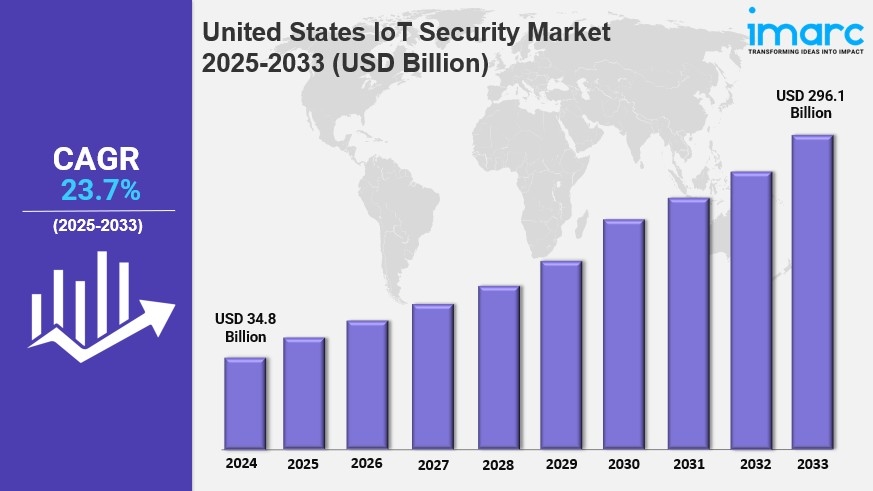United States IoT Security Market Size, Share, Trends, Growth Factors and Forecast 2025-2033

Market Overview
The United States IoT security market size was valued at USD 34.8 Billion in 2024 and is projected to reach USD 296.1 Billion by 2033, growing at a CAGR of 23.7% during the forecast period from 2025 to 2033. Growth is driven by widespread IoT device adoption, increasing cybersecurity threats, regulatory mandates, 5G technology integration, and AI/ML-powered security enhancements. The market emphasizes data privacy and secure IoT solutions amid rising endpoint vulnerabilities.
Study Assumption Years
● Base Year: 2024
● Historical Year/Period: 2019-2024
● Forecast Year/Period: 2025-2033
United States IoT Security Market Key Takeaways
● Current Market Size: USD 34.8 Billion in 2024
● CAGR: 23.7% (2025-2033)
● Forecast Period: 2025-2033
● Rising cybersecurity threats, including Advanced Persistent Threats (APTs), increasingly target IoT ecosystems.
● Regulatory mandates like the updated Internet of Things Cybersecurity Improvement Act enforce secure-by-design principles.
● Growing proliferation of smart devices across healthcare, manufacturing, smart cities, and connected vehicles expands the attack surface.
● The adoption of zero trust security models and AI-driven threat detection are key market trends.
● Increasing managed security services and third-party specialized providers are in demand for complex IoT security needs.
Sample Request Link: https://www.imarcgroup.com/united-states-iot-security-market/requestsample
Market Growth Factors
The United States IoT security market share is propelled by several key factors. Firstly, the extensive adoption of IoT devices across industries fuels market expansion. The market was valued at USD 34.8 Billion in 2024 and is forecasted to reach USD 296.1 Billion by 2033, reflecting a CAGR of 23.7%. Industries such as healthcare, manufacturing, smart homes, and transportation are increasing IoT integrations, which raises concerns regarding data privacy, network vulnerabilities, and cybersecurity threats. This trend encourages investments in endpoint security, encryption protocols, and intrusion detection systems to mitigate risks from expanded attack surfaces due to numerous IoT endpoints.
Secondly, stringent regulatory compliance is significantly influencing the market dynamics. Policies such as the Internet of Things Cybersecurity Improvement Act impose secure-by-design requirements, including mandatory device authentication and automatic software updates for IoT products sold to federal agencies. These regulations are also being adopted by private sectors, reinforcing demand for compliant IoT security solutions. Additionally, Executive Order 14117 signed in 2024 limits transfers of sensitive US data to countries of concern, thus fostering enhanced security practices. These government mandates elevate the need for advanced and integrated security measures across all IoT deployments.
Thirdly, technological advancements including 5G connectivity and the integration of artificial intelligence (AI) and machine learning (ML) within security solutions provide robust, real-time threat detection and predictive analytics. The proliferation of smart devices in automotive, smart cities, healthcare, and consumer electronics further expands the IoT ecosystem, requiring adaptive security frameworks. Companies are increasingly relying on AI-enhanced intrusion detection systems, network segmentation, and zero trust models to continuously monitor and secure IoT environments. The growing complexity of IoT networks also boosts demand for managed security services from specialized third-party providers, especially in critical infrastructure sectors like utilities and transportation.
To get more information on this market: Request Sample
Market Segmentation
Analysis by Component:
● Solutions: Includes hardware and software products such as intrusion detection systems, network security, data encryption, device authentication and control, essential for securing IoT networks across sectors like manufacturing, healthcare, and smart cities. AI-powered integrated platforms for real-time threat detection are notable.
● Services: Covers implementation, management, and maintenance of IoT security frameworks including consulting, security services management, maintenance, and support. Rapid growth in managed security services is observed as companies outsource security.
Analysis By Security Type:
● Network Security: Safeguards devices and data linked to IoT networks with VPNs, firewalls, intrusion detection/prevention systems, and access controls, crucial for smart cities, transportation, and telecommunications.
● Endpoint Security: Focuses on protecting IoT devices such as sensors, cameras, and medical devices against ransomware and malware using antivirus, endpoint detection, and device authentication with zero trust security models.
● Application Security: Secures IoT applications and software from breaches and vulnerabilities, involving secure coding, vulnerability scanning, and testing tools critical for operations like smart home automation and industrial controls.
● Cloud Security: Protects data storage and processing in cloud environments including encryption, access controls, and security posture management, driven by hybrid cloud and edge computing adoption.
● Others: Not explicitly detailed in source.
Analysis By Vertical:
● Energy and Utilities: Encompasses smart grids, connected meters, and IoT-enabled energy management with focus on protecting critical infrastructure against cyberattacks using intrusion detection and endpoint protection.
● Manufacturing: Strong demand due to Industrial IoT systems like connected machinery and robotics facing OT system attacks, necessitating network security and secure IIoT platforms.
● Automotive: Growth fueled by connected vehicle and smart transportation technologies needing encryption, secure OTA updates, and intrusion prevention.
● Transport: Includes smart transportation systems vulnerable to cyber threats, requiring robust security measures.
● Consumer Electronics: Rapid growth from smart home devices, wearables, and connected appliances with emphasis on data privacy and device vulnerability management.
● Healthcare: Critical investments due to connected medical devices prone to ransomware and data breaches.
● Others: Not explicitly detailed in source.
Regional Analysis:
The West region dominates the United States IoT security market, driven by technology hubs such as California, Washington, and Oregon. The area leads due to a strong concentration of tech companies, startups, and innovation centers, especially Silicon Valley, which is at the forefront of IoT security innovation. This region witnesses major technology firms launching cutting-edge security solutions, solidifying its market leadership.
Speak to An Analyst: https://www.imarcgroup.com/request?type=report&id=19143&flag=C
Recent Developments & News
In March 2024, the Connectivity Standards Alliance launched the IoT Device Security Specification 1.0 along with a certification program and Product Security Verified Mark, consolidating IoT cybersecurity standards from the United States, Singapore, and Europe. Additionally, the US Federal Communications Commission voted to design a voluntary cybersecurity labelling program for wireless consumer IoT products. In 2024, Oracle Communications announced integration plans with AT&T IoT connectivity in its Enterprise Communications Platform (ECP), including support from FirstNet, a public-safety-focused service running on AT&T's network.
Competitive Landscape
The competitive landscape of the industry has also been examined along with the profiles of the key players.
If you require any specific information that is not covered currently within the scope of the report, we will provide the same as a part of the customization.
About Us
IMARC Group is a global management consulting firm that helps the world’s most ambitious changemakers to create a lasting impact. The company provide a comprehensive suite of market entry and expansion services. IMARC offerings include thorough market assessment, feasibility studies, company incorporation assistance, factory setup support, regulatory approvals and licensing navigation, branding, marketing and sales strategies, competitive landscape and benchmarking analyses, pricing and cost research, and procurement research.
Contact Us
IMARC Group,
134 N 4th St. Brooklyn, NY 11249, USA,
Email: sales@imarcgroup.com,
Tel No: (D) +91 120 433 0800,
United States: +1-201971-6302
- Questions and Answers
- Opinion
- Motivational and Inspiring Story
- Technology
- Live and Let live
- Focus
- Geopolitics
- Military-Arms/Equipment
- Segurança
- Economy
- Beasts of Nations
- Machine Tools-The “Mother Industry”
- Art
- Causes
- Crafts
- Dance
- Drinks
- Film/Movie
- Fitness
- Food
- Jogos
- Gardening
- Health
- Início
- Literature
- Music
- Networking
- Outro
- Party
- Religion
- Shopping
- Sports
- Theater
- Health and Wellness
- News
- Culture

